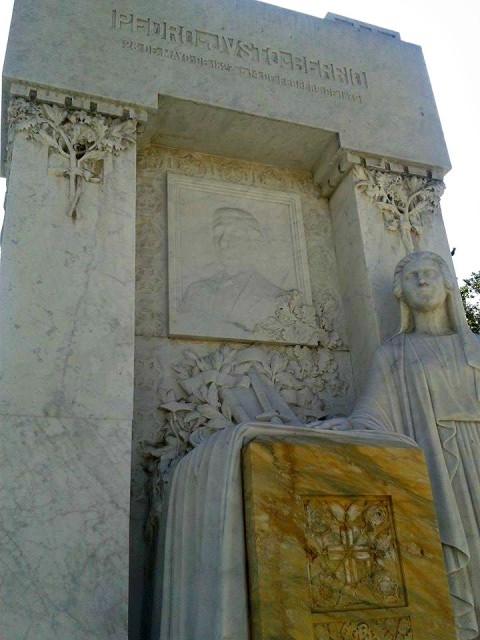The following is a guest post by Ximena Restrepo.
The cemetery as a museum is a beautiful and complex idea because it makes us question our thoughts on life, death and art.
Cementerio Museo de San Pedro is the cemetery best known for its “inhabitants,” its luxurious mausoleums and recently for its cultural agenda. It is located just a couple blocks north of Hospital Metro Station.
The History of Medellín Cemeteries
Originally, in the 1800s, Medellín’s cemeteries were not cemeteries at all. Bodies were buried in the church atrium. This tradition was inherited from European customs and expressed a belief that the proximity to the altar would guarantee a soul’s salvation.
Concerns about public health were ignored at the time; even after the first cemetery. San Benito was built in Medellín in 1809 across the Santa Elena creek and bodies continued to be buried in both churches and this designated space outside the city’s boundaries.
The second cemetery was built just twenty years later and was named “San Lorenzo” but commonly called “El Cementerio de Los Pobres” or “The Cemetery of the Poor.”
The public health situation, however, wasn’t improving and in 1842 the city’s higher class built a private cemetery first called “San Vicente de Paúl.” The name was later changed to the current “Cementerio San Pedro”.
The cemetery was declared a museum in 1998. There are still plenty of spaces open, some for rent for a four year period and others for sale for permanent placement.

Medellín Mirrored in a Museum
It has been contemplated by anthropologists in Medellín that what makes Cementerio Museo de San Pedro so different from the previous cemeteries is the fact that it mirrors the city exceptionally.
Landmarks that mark our most transited spots in the city correspond directly with some of the most important mausoleums in the graveyard.
Also, the history of the population’s behavior inside and outside of the home is revealed through their after-death wishes.
Medellín’s artistic tendencies, its musical tastes and its political history is clear in the stone cold mausoleums that reflect the City of Eternal Spring.
Pedro Justo Berrío’s mausoleum, for example, mirrors our well-known Parque Berrío. With large pieces of Italian marble, it is one of the most noticeable mausoleums in the plaza just outside the church, the most expensive space in after-death real estate.

Other mausoleums that reference the city are ex-President Carlos E. Restrepo’s resting place that echoes the university hot-spot Barrio Carlos E. Restrepo, and former professor Dr. Luis López de Mesa’s towering anchor, which references The University of Antioquia, among many other influencial figures.

Paisa culture’s “behind closed doors” habits are also exposed in the way they’re buried.
Some families chose to have their housekeepers and other help buried with them inside the mausoleum while others chose to keep them with the family but just outside the family space.
A number of mausoleums are actually built the way houses were built at a certain time, making eighties and nineties-style urban architecture very clear: in this case, aluminum doors and a foyer inside, some contain photos and other memorabilia.

Finally, Pablo Escobar’s narco-culture doesn’t escape the tell-all mirror of the city cemetery. At one point, a mausoleum belonging to one of Pablo Escobar’s hitmen had loud music playing around the clock.
It wasn’t uncommon for hitmen to be taken out to clubs after their death, tying together music, alcohol and death in sicario traditions. (This is depicted in the movie Rosario Tijeras.)
The public utilities company (EPM) shut it down several times, but it was mysteriously turned on again in a matter of hours.
After many complaints and power outages, the cemetery informed the deceased’s mother that unless the music was turned off she would lose rights to the mausoleum.

Who to Look For
The list of the famous and the wealthy buried at the museum is extensive. Among other ex-presidents, the cemetery is home to Mariano Ospina Rodríguez and son Pedro Nel Ospina who governed from 1857-1861 and 1922-1926 respectively.
San Pedro holds the remains of artists like Pedro Nel Gómez, and Bernardo Vieco, whose work can be seen on other mausoleums.

Among the wealthy lie Jose María “Pepe” Sierra, Luis Eduardo Yepes and Carlos Coriolano Amador, with their respective families in “La plaza de los Mausoleos.”
However, there are two particular tombs that stand out due to the fact that they contain no remains and are strictly symbolic.

The first, Jorge Isaacs, author of one of the most read Colombian novels María (1867), whose remains were exhumed and sent to Cali, has a sculpture of a woman who was first made nude and later clothed after the cemetery administration’s requests.
The second belongs to Argentinian tango star Carlos Gardel who died young in a plane crash arriving in Olaya Herrera Airport in 1935.
His remains were also exhumed after a few months and sent to Buenos Aires.

Cultural Events
Although some may avoid the cemetery scene considering it morbid, San Pedro is anything but gloomy, it’s also known for its cultural events and tours.
A guided tour can be arranged according to your specific interests (anthropology, history, architecture, etc.) during the day and nocturnal tours are available upon request (6 p.m. to 8 p.m.).
The cemetery is home to a variety of literature and art programs, however, a particularly interesting nocturnal event that takes place at the museum is the “Noche de Luna Llena,” it takes place every full moon and started in 2000 but has only been happening constantly since its resurrection (so to speak) in 2013.
The event consists of a nocturnal tour and a cultural presentation, such as dance or drama, done by local artists.
This Cemetery-Museum is a dynamic place that welcomes people of all ages to get involved and reunites us with the idea that death is a part of life and can be observed, not only with melancholy, but also with artistic perspective and awe.
_______
Photos: Main image, Jorge Isaacs – David Lee











